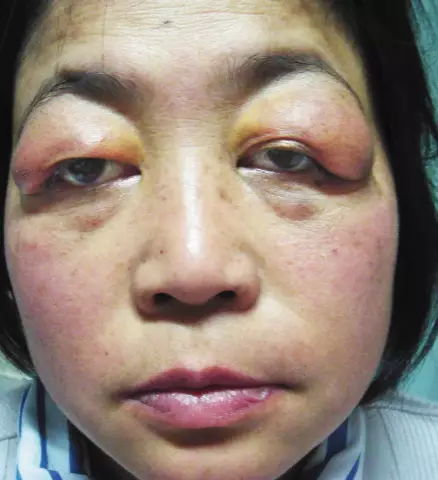- Author Rachel Wainwright [email protected].
- Public 2023-12-15 07:39.
- Last modified 2025-11-02 20:14.
Reiter's syndrome

Reiter's syndrome, or reactive arthritis, is an autoimmune inflammation of the joints, genitourinary organs, conjunctiva, and other mucous membranes. It occurs as a result of a genitourinary or intestinal infection. The most common cause of Reiter's syndrome is chlamydia, colitis, or ureaplasmosis. In the overwhelming majority of cases, the disease affects men aged 20-40 years, sometimes women. It practically does not occur in children. Complications of Reiter's syndrome can be joint dysfunction, blurred vision, erectile dysfunction, infertility. In addition, the disease adversely affects the kidneys, heart, aorta.
Reiter's syndrome symptoms
With Reiter's syndrome, symptoms begin to appear 1-2 weeks after the infection enters the body and have different localization:
- Urethra. Inflamed in the first place. In men, urination is accompanied by painful sensations. Discharge from the urethra appears. Inflammation can also affect the prostate gland. In women, the inflammatory process is easier - in the form of scanty vaginal discharge and discomfort during urination;
- Conjunctiva. Flushes and becomes inflamed. Burning, itching and watery eyes are noted;
- Joints. Inflammation and pain of varying degrees of severity appear simultaneously in the knee joint, in the toes and in the tubercle of the calcaneus. In severe cases, the joints of the spine become inflamed;
- Mucous membranes. Small painless ulcers appear on the tongue, mouth and glans of the penis;
- Leather. Under the nails, the skin color may take on a yellowish tint, and characteristic dense spots are observed on the palms and soles.
After 3-4 months, these symptoms of Reiter's syndrome disappear, but arthritis may recur. Sometimes deformities of the joints and spine develop. In rare cases, incapacity for work occurs.
Diagnostics of the Reiter's syndrome
Diagnosis of Reiter's syndrome is carried out on the basis of complaints of patients, anamnesis and the identification of a combination of conjunctivitis, arthritis, enterocolitis and urethritis. Laboratory and instrumental data confirm the diagnosis.
Laboratory tests include a general and biochemical blood test, a general urine test. The presence or absence of chlamydia is established by the polymerase chain reaction method. A cytological examination of the mucous membrane of the urethra, cervical canal and conjunctiva, as well as the juice of the prostate gland and sperm, is performed. In addition, synovial fluid is examined and the carrier of HLA B27 is detected.
X-rays of the joints reveal asymmetric narrowing of the joint spaces and asymmetric para-articular osteoporosis. If the X-ray diagnosis of Reiter's syndrome is carried out with a long course of the disease, then erosive and destructive changes are likely - a heel spur, isolated spurs on the vertebrae, multiple joint erosions. In about half of the cases, unilateral sacroiliitis is found.

The diagnostic criteria are:
- Chronological relationship between intestinal or genitourinary infection and the appearance of signs of arthritis, conjunctivitis, and lesions of the mucous membranes and skin;
- Age and sex of patients;
- Acute arthritis of the joints of the lower extremities with heel bursitis and enthesopathy;
- Inflammation of the genitourinary tract and chlamydia found in the scraping of the epithelium of the cervical canal or urethra;
- Asymmetric seronegative oligoarthritis, cercivitis, or nonspecific urethritis.
Treatment of Reiter's syndrome
In Reiter's syndrome, treatment is not always successful and can be quite long. During the acute period of the disease, patients are prescribed antibiotics such as tetracycline or erythromycin. The course lasts 3-4 weeks at an average dosage. Arthritis is treated with anti-inflammatory, non-steroidal drugs. If there is no effect, then glucocorticoids are injected into the inflamed joint. In chronic course, long-term use of quinoline drugs is shown, but sometimes inflammation of the joints and spine recurs. Severe conjunctival inflammation is treated with eye drops or corticosteroid ointments. To prevent Reiter's syndrome, it is necessary to observe sexual hygiene, prevent intestinal infections and treat urethritis and enterocolitis in time.
YouTube video related to the article:
The information is generalized and provided for informational purposes only. At the first sign of illness, see your doctor. Self-medication is hazardous to health!






